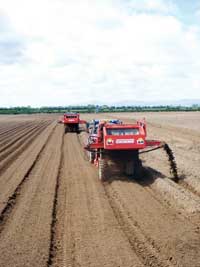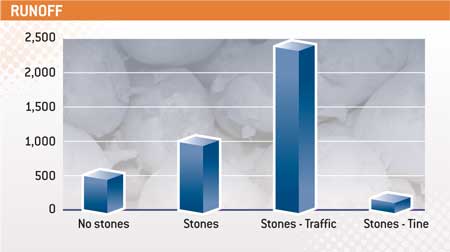Practical tips for reducing run-off

Breaking up compaction in stone rows with a tine during spring planting and growing a cover crop in the previous autumn are two ways potato growers can reduce run-off. Philip Case reports
Potatoes are often considered a “high risk” crop due to the intensive cultivations required before planting, which include bedforming and de-stoning. But new research shows that growers can cut run-off by adopting simple practical measures.
“Raised bed systems which channel water in furrows, the frequent traffic for spraying and irrigation, and typically late harvests, can increase the risk of run-off,” says ADAS soil and water scientist Martyn Silgram.
“Soil compaction associated with these processes can limit rooting depth, reduce water and nutrient availability, reduce tuber yield and quality, increase the risk of waterlogging and tuber rot diseases, and lead to inefficient use of irrigation and fertilisers.”
A DEFRA-funded project, which runs to 2013, aims to find ways to minimise the risk of soil compaction, improve surface infiltration, and minimise surface run-off and losses of soil (sediment), phosphorus, nitrogen and surface applied products, such as herbicides, to watercourses.
Last season, Dr Silgram, in collaboration with the Potato Council and Briggs Irrigation, looked at run-off losses from no-stone rows, stone rows without traffic, and stone rows receiving spray and irrigation passes. He also explored whether the use of a winged tine could lift the compaction just beneath the stone layer in a no-traffic row and reduce run-off by increasing infiltration.
Results show that around 5% of rainfall and irrigation applied to potato crops on gently sloping (4-degree) fields with silty loam and loamy sand soils was lost as surface run-off – with most lost down stone rows.
Stone rows had much greater losses than rows without stones, with significantly greater losses from stone rows receiving repeated traffic, says Dr Silgram.
“Losses of water down stone rows with traffic represented 15-18% of water applied in rain and irrigation, compared with around 5-6% down stone rows without traffic and 1-3% down stone rows. However, the tine proved effective at reducing losses with no discernible effect on yield (see graph).”
But in commercial planting, although stone rows receiving traffic have the highest losses, there are many fewer of them, being 24m apart.
Consequently at whole field scale, it was the stone rows without traffic which were the most important because they were so numerous, with most field scale losses originating from these rows. Overall run-off losses represented 4.2-5% of the rainfall plus irrigation water applied during the season, says Dr Silgram.
Research also show that measures in the previous autumn can help minimise run-off. In a separate trial, he analysed run-off from replicated 60-100m long field sections with 4 degree slopes on a silty clay loam (Herefordshire) and loamy sand (Shropshire).
Most surface run-off, sediment and phosphorus loss occured down compacted and unvegetated tramline wheelings used for spraying operations in the previous cereal crop.
But these losses can be substantially reduced if a cover crop precedes potato planting, Dr Silgram notes.
When a mustard cover crop is grown before potato planting in the spring, 15-20kg N/ha that would otherwise have been lost through leaching is typically retained in the soil and potentially available to the next crop.
“A mustard cover crop is ideal before potatoes, as it grows rapidly, locking up nitrogen that would otherwise be leached, has biofumigant properties, is not frost hardy, and decomposes rapidly,” he explains.

Run-off from loamy sand site under alternative management of land the winter before potatoes.
| Key findings * Tramline wheelings are important pathways for run-off and diffuse pollution when potatoes follow cereals, but with careful timing, cover crops and shallow cultivation are practical methods which can substantially mitigate over-winter losses. * In the potato season, stone rows are the main loss pathway for run-off and associated pollutants (sediment, phosphorus, nitrogen, surface applied products). * Work is now investigating a range of practical options for managing the stone rows between potato beds to minimise compaction and help maintain good tuber yields. |
|---|

